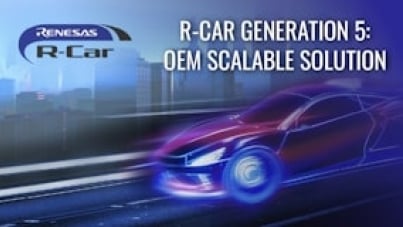急速に進化する自動車業界では、従来の分散型アーキテクチャから、集中型コンピューティングとドメイン統合を組み合わせたアーキテクチャへの移行が進んでいます。また、ADAS(高度運転支援システム)機能の普及により、より自律的な運転への動きが加速しています。こうした変化は、ハードウェア中心のモデルからソフトウェア定義車両(SDV)モデルへの変化を促すものでもあります。そして、このような変化は総じて、より高度なコンピューティングニーズに対応するSoCの需要増加につながっています。この時、将来の車両を構築し、進化を続けるためには、SoCと共に信頼性の高いオープンな開発環境も必要です。
ルネサスは、スケーラブルなSoCポートフォリオを拡充し、第5世代(Gen 5)R-Car SoCs で、最新のチップレット技術および最先端車載プロセスノードを組み合わせた新しいソリューションを提供します。ルネサスのR-Car Gen 5 SoCは、SDV車両アプリケーションと高度な自律性の実現に向けて、集中型コンピューティングとクロスドメインに対応するアーキテクチャとなっています。このスケーラブルなポートフォリオは、エントリーレベルの量産車からプレミアム車まで、あらゆるレベルの車両にソリューションを提供します。一方、SDV環境は、共通アーキテクチャにより、デバイスや世代を超えたソフトウェアの再利用性と移植性を実現し、進化する自動車業界に持続可能で効率的な開発アプローチを提供します。R-Car Gen 5 SoCは、高いスケーラビリティ、柔軟性、電力効率、およびミクスド・クリティカリティの実現という価値を提供します。
スケーラブルな高性能プラットフォームで集中型アーキテクチャに対応
R-Car X5Hの主な特長:
- 32個のArm® Cortex®-A720AE CPUコアで1,000k DMIPS以上の性能を実現し、高度なコンピューティングアプリケーションに対応
- 6個の Cortex-R52 CPU コア(ロックステップ)でリアルタイム 処理に対応し、60k DMIPS以上の性能を実現してASIL Dをサポート
- 最適化された NPU とDSPを実装し、最大400 TOPS(注1)のAI演算性能を実現することで高効率を追求
- 最大4 TFLOPS相当(注2)のグラフィックス性能。GPU上のハードウェアの仮想化をサポート
- マルチ4Kメディア、マルチメガピクセルカメラとマルチディスプレイでプレミアムADAS/IVI用のビデオおよびビジョン処理をサポート
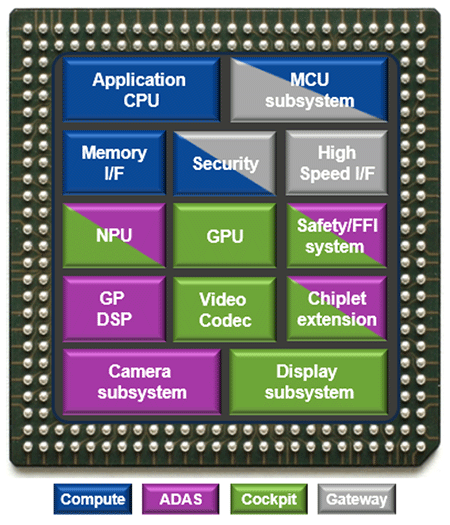
フレキシブルなモジュール型アーキテクチャでOEMの性能ニーズに対応
集中型アーキテクチャでは、ドメインの統合レベルはさまざまです。エントリ車両向けでは、コスト削減のためにADAS+IVI+ゲートウェイを1つのSoCに完全に統合するケースが見られますが、ミッドレンジ以上の車両では、演算能力を向上させるために専用のドメインを組み合わせるのが一般的です。R-Car X5Hは集約型からドメイン型まで、あらゆるアプリケーションに対応できます。UCIeインタフェースを使用することでチップレットを追加し、アプリケーションのニーズに応じてAIやグラフィック性能の向上を図ることができます。このチップレット技術によって異種チップを集積し、パフォーマンスをスケーリングすることが可能です。開発環境として、独自のRoX SDVプラットフォームも用意していますので、R-Car X5Hを使用した集中型フュージョンアプリケーション開発においては、ADAS、コクピット、ゲートウェイのソリューションスタック(商用およびOSSの両方)を利用できます。

ハイエンドの高級車では、優れた演算能力が必要なADASに特化したマルチドメイン型の車載コンピュータアーキテクチャが採用される場合もあります。R-Car X5H(400 TOPS)のAI機能と2つのUCIeインタコネクトを活用すれば、マルチダイパッケージのAIチップレット集積技術で追加チップレットを集積し、演算能力を向上させることができます。ルネサスのAIソリューション開発コンセプトであるAIギガファクトリ(AIツールチェーン、ネットワーク/モデルサポート、クラウドネイティブサポート)と組み合わせることで、お客様は自動運転のあらゆるニーズに対応したエンドツーエンドのプラットフォームを構築できます。
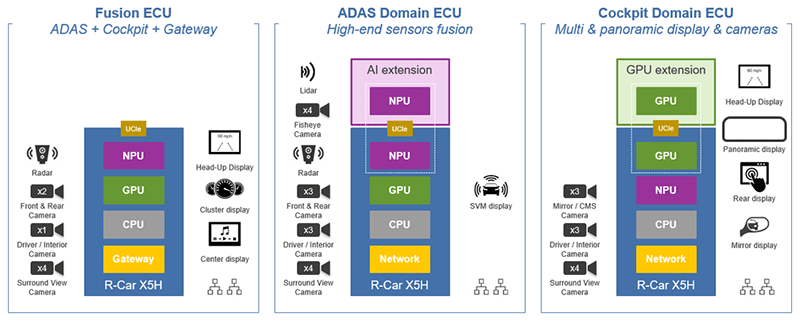
R-Car X5Hのダイ間接続には最新のUCIeインタフェースが採用されており、マルチダイシステムにおける相互運用性を促進し、OEMのニーズに応じて柔軟に組み合わせることが可能です。また、カスタムアクセラレータを統合することも可能です。このようなオープンアーキテクチャを実現しながら、オーバーヘッドを最小限に抑え、より高いパフォーマンスを実現するために、チップレットアプローチが採用されています。これらの拡張機能はすべて、最新の自動車の安全およびセキュリティ要件に準拠しています。
最先端技術によるクラス最高の電力効率
複数のドメイン機能を単一のモジュールに統合する際の課題の1つは、熱や電力の管理です。R-Car X5Hは、最新の非常に電力効率の高い3nmプロセス技術を採用しています。特に性能と電力効率のバランスを考慮して、最新のプロセスノードを選んだことで、特定の作業負荷では、一般的な5nmプロセスと比較して30~35%(注3)も削減できます。これにより、R-Car X5Hは、クラス最高レベルの電力効率(TOPS/W)で高い演算性能(360度認識のためのAI処理など)をサポートし、トータルの消費電力を低減することができます。R-Car X5Hは、システム制御プロセッサ(SCP)も統合しているため、駐車モードや見張りモードなどのアプリケーション向けにさまざまな低電力モードをサポートしています。
マルチドメイン統合のためのセキュアな分離
機能安全(FuSa)は、マルチドメインSDVアーキテクチャにとって非常に重要です。ひとつのSoCにクリティカリティの異なる複数のアプリケーションを統合する場合、FuSaでは連鎖的な故障を防ぐために、厳格なドメイン分離または無干渉(FFI:Freedom From Interference)が求められます。現在市場に出回っている製品の多くは、ハイパーバイザやSafety OSなどソフトウェアによってこれを実現しています。しかし、ソフトウェアベースのアプローチは、ハードウェアベースのアプローチほど堅牢ではありません。ハードウェアベースの FFI ソリューションであれば、安全性を確保しながら単一チップ上にマルチドメインを統合できます。 安全規格に準拠したデバイスを長年に渡って提供してきたルネサスにとって、安全性とセキュリティはもはや DNA の一部です。 R-Car Gen 5 SoC は、ルネサス独自の、市場実績のあるハードウェアベースの FFI 技術を使用しており、マルチドメイン統合に際して各ドメインを極めて堅牢に分離します。このソリューションは、周辺機能レベル、メモリレベル、帯域幅など、複数のレベルで分離を実現します。Region ID、メモリ保護、高度なQoSなどの機能も備えています。
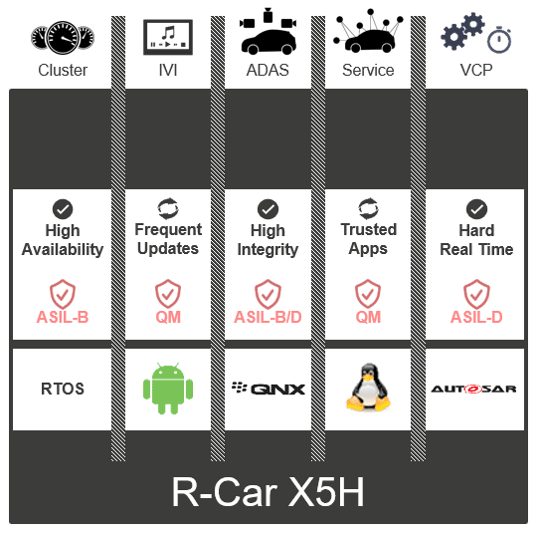
R-Car Open Access(RoX)開発プラットフォーム
R-Car X5Hを含む、R-Car Gen 5 SoCは、SDV開発を加速させることができるよう、開発環境としてR-Car Open Access(RoX)SDVプラットフォームを提供します。RoXプラットフォームには、車載システムの開発者が次世代の車両を迅速に開発し、安全性を確保しながらソフトウェアアップデートを継続的に実施するために必要なハードウェア、ソフトウェア(OS、MW、アプリ)、ツールを統合しています。RoXは、OEMやTier1サプライヤが仮想環境やハードウェア上で、ADASやIVI、ゲートウェイ、クロスドメインフュージョンシステム用のスケーラブルなコンピューティングソリューションを幅広く開発・実装できる柔軟性に富んだプラットフォームです。クラウドサポートを活用してシームレスに展開することも可能です。
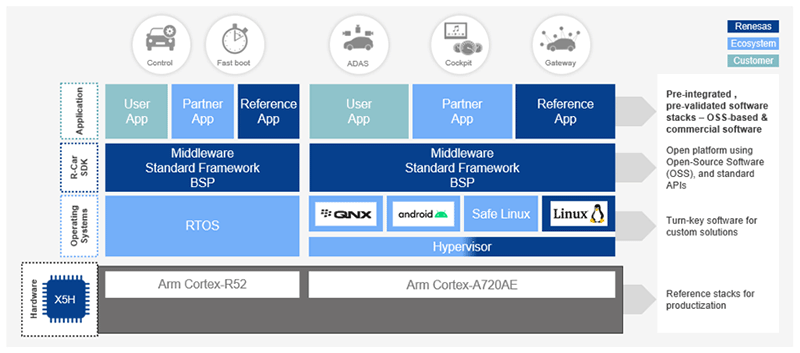
ルネサスはR-Car Gen5によってカスタマエクスペリエンスを進化させ、SDVアーキテクチャの未来を推進します。チップ自体の優れた性能だけでなく、チップレット技術によってスケーラビリティを向上させ、Armアーキテクチャで統一したMCUからSoCまでの製品ポートフォリオを順次提供していく予定です。R-Car Gen 5は、クロスドメインやドメイン固有の集中型/ゾーン型アーキテクチャと組み合わせることで、ADASやコクピット、ゲートウェイ、車載制御などのさまざまなアプリケーションに対応し、お客様の幅広いプラットフォームニーズに応えます。最新の3nm車載プロセス技術とルネサス独自のハードウェアベースFFIソリューションを採用したR-Car Gen5は、イノベーションの最先端を行く製品です。コスト効率に優れ、市場投入までの時間が短く、クラス最高レベルの電力効率を実現するだけでなく、ルネサスの車載用製品ならではの堅牢な機能安全も備えています。
(注1)Sparse TOPS
(注2)TFLOPSはManhattan 3.1のベンチマークデータを基準に算出
(注3)ルネサスの設計の実装に基づく推測値
ニュース&各種リソース
| タイトル | 分類 | 日時 |
|---|---|---|
| SDV開発を加速する、商用利用可能なソフトウェアを備えたR-Car Open Access(RoX)プラットフォームを提供開始 | ニュース | 2024年6月20日 |

